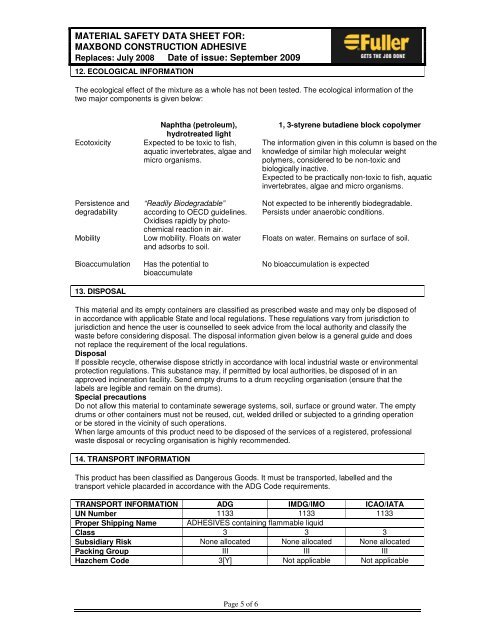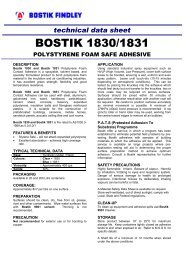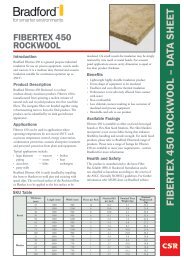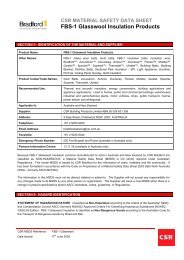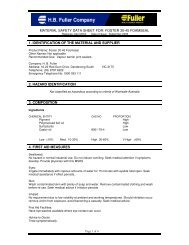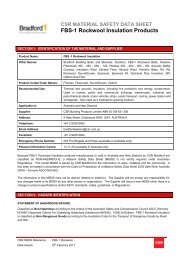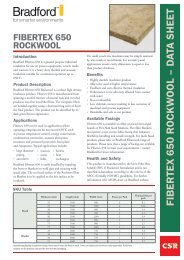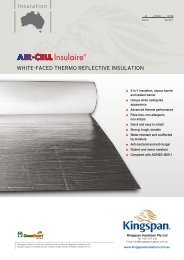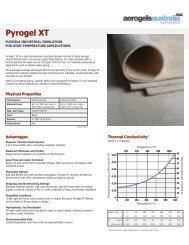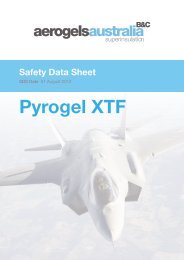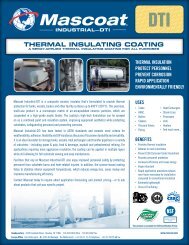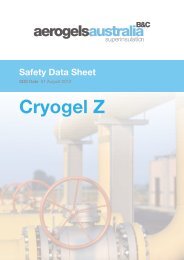Maxbond MSDS - Insulation Industries
Maxbond MSDS - Insulation Industries
Maxbond MSDS - Insulation Industries
Create successful ePaper yourself
Turn your PDF publications into a flip-book with our unique Google optimized e-Paper software.
MATERIAL SAFETY DATA SHEET FOR:<br />
MAXBOND CONSTRUCTION ADHESIVE<br />
Replaces: July 2008 Date of issue: September 2009<br />
12. ECOLOGICAL INFORMATION<br />
The ecological effect of the mixture as a whole has not been tested. The ecological information of the<br />
two major components is given below:<br />
Ecotoxicity<br />
Persistence and<br />
degradability<br />
Mobility<br />
Bioaccumulation<br />
13. DISPOSAL<br />
Naphtha (petroleum),<br />
hydrotreated light<br />
Expected to be toxic to fish,<br />
aquatic invertebrates, algae and<br />
micro organisms.<br />
“Readily Biodegradable”<br />
according to OECD guidelines.<br />
Oxidises rapidly by photochemical<br />
reaction in air.<br />
Low mobility. Floats on water<br />
and adsorbs to soil.<br />
Has the potential to<br />
bioaccumulate<br />
1, 3-styrene butadiene block copolymer<br />
The information given in this column is based on the<br />
knowledge of similar high molecular weight<br />
polymers, considered to be non-toxic and<br />
biologically inactive.<br />
Expected to be practically non-toxic to fish, aquatic<br />
invertebrates, algae and micro organisms.<br />
Not expected to be inherently biodegradable.<br />
Persists under anaerobic conditions.<br />
Floats on water. Remains on surface of soil.<br />
No bioaccumulation is expected<br />
This material and its empty containers are classified as prescribed waste and may only be disposed of<br />
in accordance with applicable State and local regulations. These regulations vary from jurisdiction to<br />
jurisdiction and hence the user is counselled to seek advice from the local authority and classify the<br />
waste before considering disposal. The disposal information given below is a general guide and does<br />
not replace the requirement of the local regulations.<br />
Disposal<br />
If possible recycle, otherwise dispose strictly in accordance with local industrial waste or environmental<br />
protection regulations. This substance may, if permitted by local authorities, be disposed of in an<br />
approved incineration facility. Send empty drums to a drum recycling organisation (ensure that the<br />
labels are legible and remain on the drums).<br />
Special precautions<br />
Do not allow this material to contaminate sewerage systems, soil, surface or ground water. The empty<br />
drums or other containers must not be reused, cut, welded drilled or subjected to a grinding operation<br />
or be stored in the vicinity of such operations.<br />
When large amounts of this product need to be disposed of the services of a registered, professional<br />
waste disposal or recycling organisation is highly recommended.<br />
14. TRANSPORT INFORMATION<br />
This product has been classified as Dangerous Goods. It must be transported, labelled and the<br />
transport vehicle placarded in accordance with the ADG Code requirements.<br />
TRANSPORT INFORMATION ADG IMDG/IMO ICAO/IATA<br />
UN Number 1133 1133 1133<br />
Proper Shipping Name ADHESIVES containing flammable liquid<br />
Class 3 3 3<br />
Subsidiary Risk None allocated None allocated None allocated<br />
Packing Group III III III<br />
Hazchem Code 3[Y] Not applicable Not applicable<br />
Page 5 of 6


